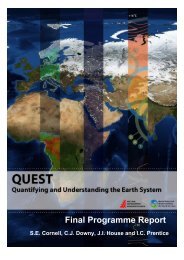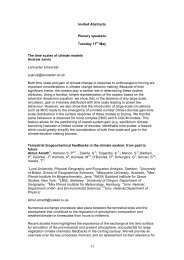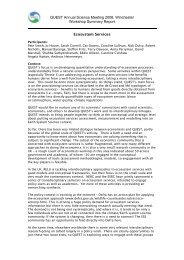Outcome - QUEST - bris
Outcome - QUEST - bris
Outcome - QUEST - bris
You also want an ePaper? Increase the reach of your titles
YUMPU automatically turns print PDFs into web optimized ePapers that Google loves.
Advances in large-scale, generic crop modelling<br />
It is common knowledge that intensified human activity and growing population have<br />
changed the climate and the land biosphere. One of the most widely accepted human<br />
perturbations is the emission of carbon dioxide (CO 2 ) by fossil fuel burning and land use<br />
change. As the terrestrial biosphere is an active player in the global carbon cycle, changes<br />
in land use feed back to the climate of the earth through regulation of the content of<br />
atmospheric CO 2 , the most important greenhouse gas, and changing albedo (e.g., energy<br />
partitioning).<br />
Recently, the climate modelling community has started to develop more complex Earth-<br />
System models that include marine and terrestrial biogeochemical processes in addition<br />
to the representation of atmospheric and oceanic circulation. However, most terrestrial<br />
biosphere models only simulate natural, or so-called potential vegetation and do not<br />
account for managed ecosystems such as croplands and pastures, which make up nearly<br />
one-third of the Earth’s land surface. On the other hand, over the past 30 years numerous<br />
models of crop growth have been developed, and these have proved to be extremely<br />
useful tools for scientists and managers of agricultural systems. However, these detailed<br />
models are typically application orientated and, therefore, are usually applied specifically<br />
to particular crops and locations. These models were not originally designed for largescale<br />
studies and don’t include complete nutrient or carbon cycles.<br />
A workshop held at the Rothamsted Research Centre, UK, dealt with the advancing<br />
science of including large-scale, generic crop modelling schemes in global terrestrial<br />
biosphere models. About twenty scientists from the crop modelling and global biosphere<br />
modelling community attended this meeting. This international workshop was one in a<br />
series of workshops sponsored by <strong>QUEST</strong> (Quantifying and Understanding the Earth<br />
System; see http://quest.<strong>bris</strong>.ac.uk for more information on <strong>QUEST</strong> and on the<br />
workshop), a program of the U.K. Natural Environment Research Council (NERC).<br />
<strong>QUEST</strong> has several activities among them the focused strategic activity on Earth System<br />
Modelling and two research themes on (1) the contemporary carbon cycle and its<br />
interactions with climate and atmospheric chemistry, and (2) the implications of global<br />
environmental changes for the sustainable use of resources.<br />
Setting the scene<br />
In order to be able to model crop productivity and yields on a global scale we need<br />
information on current and previous land cover, land use practices, and changes in land<br />
management over time. For the past, this has been done using a combination of census<br />
data on cropland inventories and land cover classification from satellite data. This<br />
‘statistical data fusion’ can then produce a calibrated map of croplands. By using a<br />
‘hindcast modelling’ approach (combining a land cover change model with historical<br />
cropland inventory data) Navin Ramankutty and colleagues at the University of<br />
Wisconsin-Madison Center for Sustainability and the Global Environment (SAGE)<br />
extended the 1992 cropland map into the past to the year 1700. Recently SAGE has
produced global data sets of the early 1990s distribution of 18 major crop types at a<br />
spatial resolution of appr.10 km. SAGE is continuing work to derive global maps of<br />
present crop types, planting/harvest date, fertilizer application rates and irrigation water<br />
application rates. All of these data are extremely useful drivers for modelling crops.<br />
While much uncertainty surrounds future agricultural land use and farmer adaptation to<br />
climate change, alternative scenarios of future management can be used to drive crop<br />
models over the 21 st century. Frank Ewert and colleagues at Wageningen University and<br />
Université catholique de Louvain have developed such quantitative and spatially explicit<br />
scenarios of future agricultural land use across Europe. They constructed future<br />
agricultural land-use locations for 3 time slices (2020, 2050 and 2080) at a spatial<br />
resolution of 10 min latitude and longitude. The scenarios were based on an interpretation<br />
of the four storylines of the Special Report on Emission Scenarios (SRES) of the<br />
Intergovernmental Panel on Climate Change (IPCC) using a simple supply/demand<br />
model of agricultural area quantities at the European scale and disaggregated these<br />
quantities using scenario-specific, spatial allocation rules.<br />
Assumptions about future technological advancement and estimated changes in crop<br />
productivity have significant impacts on future agricultural land use in Europe. If<br />
technology continues to progress at current rates then cropland and grassland areas may<br />
decline by as much as 50%. As a result, a large area of agricultural land in Europe could<br />
be used for other purposes. Expansion of urban areas, and specific management for<br />
bioenergy crops, forests, and recreation are possible alternative land uses for the future.<br />
Different modelling strategies<br />
Given the current datasets for past, present, and future agricultural land management,<br />
what types of modelling approaches are currently implemented? Altogether six different<br />
groups representing five different models (LPJ, IBIS, DAYCENT, ORCHIDEE, GLAM)<br />
presented current approaches. Most of the groups have extended their original terrestrial<br />
ecosystem models to include representation of crop growth but have kept the<br />
representation of biophysical processes identical to the original model formulation where<br />
possible (e.g. photosynthesis, respiration, hydrology). Many of the models have been<br />
extended by new algorithms for crop management (hybrid selection, planting and<br />
harvesting date, irrigation, fertilization, intercropping and multiple cropping), crop<br />
phenology, growth and carbon allocation. They mainly differ in the detail of processes<br />
and which crop types are represented. The level of process details included can vary<br />
substantially across models. For example, the most detailed models (for applications on a<br />
continental scale) include definitions of growth stages (planting to leaf emergence, leaf<br />
emergence to the end of silking, and grain fill to physiological maturity) and nitrogen<br />
availability (atmospheric deposition, fixation, fertilizer application, and mineralization of<br />
soil organic matter). Usually the major crop types such as maize, soybean, wheat and rice<br />
are incorporated, however, it is an open question about the choice and number of<br />
cultivars, which is needed for large-scale, generic crop modelling.
The group at the Potsdam Institute for Climate Impact Research implemented so-called<br />
crop functional types (CFTs) to model phenology and growth of the world dominant crop<br />
or rangeland types within LPJ. The natural vegetation, represented by plant functional<br />
types (PFTs), and CFTs can coexist within a mixed grid cell on two different land cover<br />
types. PFTs are all mixed within the ‘natural’ land cover and compete for resources,<br />
whereas each CFT is located on a distinct stand with its own water budget within the<br />
‘agricultural’ land cover. According to the climate, the model estimates several varietyspecific<br />
parameters in order to ensure that the crop simulated represents the type most<br />
likely used by the farmers in that specific environment. Consequently, the model<br />
simulates the adaptation by variety selection across the climatic zones and with climate<br />
change.<br />
The French group at the Laboratoire des Sciences du Climat et de l'Environnement<br />
(LSCE) is pursing a different approach. They have developed a hybrid model consisting<br />
of the dynamic global vegetation model ORCHIDEE and the standalone agronomy model<br />
STICS. Whenever there is an agricultural land cover type ORCHIDEE is calling STICS<br />
and handing over all the necessary climate data STICS needs to calculate crop growth. In<br />
return, STICS passes biogeochemical and biophysical variables such as leaf area index,<br />
root profile, canopy height, irrigation, and nitrogen stress back to ORCHIDEE. This<br />
strategy has been implemented for three different cultivars.<br />
At the moment all the models are more or less at the same development state of having<br />
been tested and validated at some specific sites and are producing their first results. IBIS<br />
has been applied across the Mississippi Basin to investigate the influence of land<br />
cover/land-use changes on nitrate export to the Gulf of Mexico, and how climate change<br />
and variability may have previously impacted crop yields and farmer decision-making.<br />
GLAM, for example, has been coupled to a climate model to also account for the<br />
difference in biophysical attributes of cultivated plants compared to natural vegetation<br />
and then used for modelling groundnut yield in India. DAYCENT and LPJ have been<br />
applied globally and tested against country data from the Food and Agricultural<br />
Organization (FAO).<br />
One major outcome of this workshop was the agreement to create a dataset consisting of<br />
all the necessary information (climate, planting/harvesting date, phenology, fertilizer<br />
application, irrigation application, yield, carbon, water and energy fluxes) for validating<br />
and driving these hybrid crop-terrestrial ecosystem models. This dataset, if combined<br />
with a standardized modelling protocol, can then also be used for a future modelling<br />
intercomparison project. Ideally this dataset should comprise observations on a field scale<br />
but also across larger spatial and temporal scales using available census data. There are<br />
various existing data sources such as the FAO dataset and other (sub-) national statistics<br />
as well as remote sensing data, the Global Change and Terrestrial Ecosystems (GCTE)<br />
Focus 3 (Agroecology and Production System) networks, FLUXNET, Free Air Carbon<br />
Dioxide Enrichment (FACE) experiments and field observations at farm level (e.g. the<br />
Farm Accountancy Data Network in Europe).
The workshop “LARGE SCALE, GENERIC CROP MODELLING” was held 9-11<br />
March, 2005, at Rothamsted Research, Harpenden, U.K.<br />
Author Information:<br />
Marko Scholze, <strong>QUEST</strong>, University of Bristol, UK; Alberte Bondeau, Potsdam Institut<br />
für Klimafolgenforschung (PIK) e.V., Potsdam, Germany; Frank Ewert, Wageningen<br />
University, Netherlands; Chris Kucharik, SAGE, University of Wisconsin-Madison; Jörg<br />
Priess, University of Kassel, Germany; Pascalle Smith, LSCE, Gif-sur-Yvette, France












